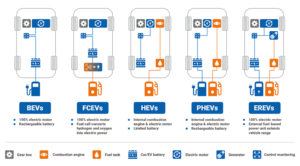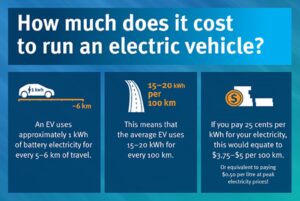Electric vehicles (EVs), are more than just a way to get from point A to point B. They’re a revolution. They mark the start of our transition from fossil fuel-powered vehicles to a cleaner, greener way of driving. They’re sophisticated and quiet.
Battery Electric Vehicles (BEV)
Run only on electricity. They don’t produce emissions and the battery capacity determines the driving range.
Hybrid Electric Vehicles (HEV)
Hybrids have an electric motor and petrol engine set up. It can power independently of each other or the petrol engine acts as a generator to charge the battery.
Plug-in Hybrid Electric Vehicles (PHEV) or (PIEV)
Uses both fuel and electricity. The battery is charged via a plug-in outlet and regenerative braking. These cars typically travel purely on electricity before the combustion engine takes over the job, increasing the car’s range.
Fuel-cell Electric Vehicles (FCEV)
Compressed hydrogen and oxygen generate electricity to power the car’s motor. FCEVs only emit water vapour and typically have a greater range than battery-powered cars

What are the benefits of EVs?
Reducing Greenhouse Gas Emissions
Reduces air pollution, if you use solar energy to recharge your car from home, you can reduce your carbon footprint even further.
Health
Air Quality – An average new Internal Combustion Engine vehicle emits around 185g CO2/km, whereas an average new EV emits around 98g CO2/km. Increased adoption of battery electric vehicles has the potential to significantly improve air quality and reduce strain on our health system.
Noise levels – EV’s can significantly decrease Australia’s current average of 76dB, similar level of an alarm clock. Reducing noise can help decrease risk of elevated blood pressure, coronary artery disease, hearing loss and even heart attacks.
Cost
Lower running cost thanks to fewer moving parts. In addition, the price on average to recharge EV’s is approximately $0.33 depending on energy suppliers, which is less than the price to refuel a combustion engine vehicle approximately $1.50 per litre.
National Fuel Security
With electricity generated domestically, we will lessen our reliance on importing liquid fuel to sustain our transport sector.

What to consider before leasing an electric vehicle
The Distance You Drive
A battery EV and its range is determined by the capacity of its battery and how much charge it has left. The network of ultra-fast charge stations is steadily increasing along highways, they’re not quite as abundant as petrol stations are. EVs are cheaper than fuel although the time it takes to recharge an EV is a lot longer than the time it takes to refill a petrol tank. To ensure a smooth ride always plan ahead, top up regularly, before starting your journey.
The Environmental Impact
While BEVs emit zero emissions on the road, they’re not entirely clean-handed when it comes to their impact on the environment. CO2 emissions still come into play when electric cars and batteries are manufactured, and in the generation of electricity to charge the vehicle when the power is sourced from fossil fuels.
Grants, Subsidies & Incentives
New South Wales
Subsidy – The first 25,000 new battery-electric or hydrogen fuel cell vehicles purchased below $68,750 including GST will receive a $3,000 rebate.
Stamp Duty – the state government will waive stamp duty payable on both new and used EV and hydrogen fuel cell vehicles purchased for less than $78,000 including GST.
Road Costs – NSW is planning to roll out an EV tax 2.5c p/km (EV) and 2c p/km (Hybrids). However, this has been deferred till 2027.
Victoria
Stamp Duty – In Victoria EV’s are exempt from the luxury car stamp duty (vehicles over $68,740), instead of $18 per $200 market value for combustion engines EV’s will pay $8.40.
Registration – $100 off their annual registration costs for simply owning an EV.
Subsidy – The Victorian Government has also introduced the ZEV subsidy, which can lower the cost of a new EV under $68,740 by $3,000. However, this offer is limited to 4,000 registrations currently, with an additional 16,000 spots to be made available at a yet-to-be-determined time.
Road Costs – From July 1st 2021 drivers will pay an EV tax 2.5c p/km (EV) and 2c p/km (PHEVs). This requires road users to provide a photo image of their vehicle’s odometer.
Tasmania
Stamp Duty – two-year stamp duty waiver on both new and second-hand electric vehicles.
Queensland
Stamp Duty – drivers pay $2 per $100 market value up to $100,000, and $4 per $100 after the threshold. Comparatively, combustion engine vehicles pay up to $6.
Australian Capital Territory
Stamp Duty – $0 in stamp duty on new EV purchases.
Registration – new and used vehicles receive two years’ worth of free registration.
Loans – the ACT government offers interest-free (yes, 0% interest) loans of up to $15,000 to help cover the upfront costs of buying an electric vehicle.
South Australia
Road Costs – SA is also planning to roll out an EV tax 2.5c p/km (EV) and 2c p/km (Hybrids). However, this has been deferred till July 2022.
Western Australia
Uber, taxi or charter vehicle – drivers will be exempt from the 10 per cent on-demand transport levy in Western Australia by driving an electric vehicle.
Northern Territory
Registration – Removal of registration component for five years from July 2022.
Stamp Duty – Reduced stamp duty by $1,500 on first-time registration of new and second hand for five years from July 2022.
If you are looking to lease, purchase or manage an EV for personal or business contact StreetFleet about the possible subsidies and grants applicable within your local state or territory.
Read the full guide with reference sources here


